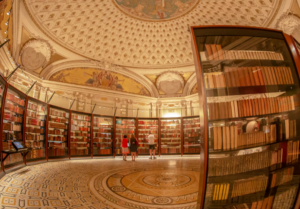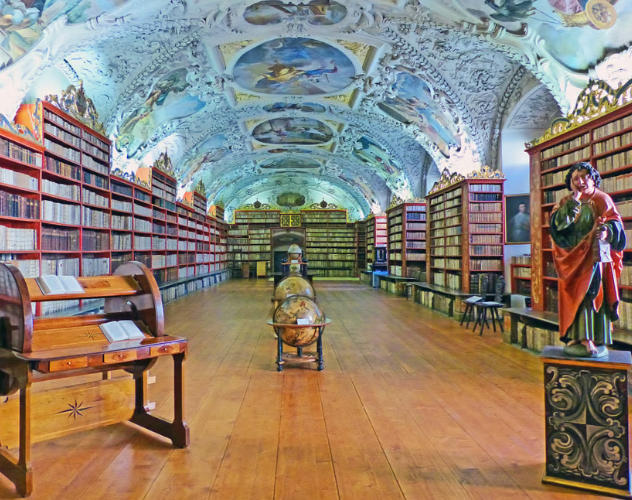Libraries, the guardians of human wisdom, stand as venerable institutions that have withstood the test of time. This comprehensive exploration delves into the oldest libraries across the globe, revealing the rich histories, architectural wonders, and the enduring legacy of these hallowed repositories of knowledge.

The Ancient Libraries: A Glimpse into Antiquity
The Library of Ashurbanipal (circa 7th century BCE)
Located in Nineveh (modern-day Iraq), the Library of Ashurbanipal is one of the earliest known libraries. Assembled by the Assyrian king Ashurbanipal, it housed a vast collection of cuneiform tablets, offering insights into the culture and knowledge of ancient Mesopotamia.
The Royal Library of Alexandria (3rd century BCE)
The Royal Library of Alexandria, Egypt, is an iconic symbol of ancient learning. Established during the reign of Ptolemy II, it housed an extensive collection of scrolls and manuscripts. Despite its eventual demise, the library remains a beacon of classical knowledge.
Medieval Marvels: Preserving Manuscripts in Monastic Settings
Saint Catherine’s Monastery Library (circa 6th century CE)
Nestled at the foot of Mount Sinai in Egypt, Saint Catherine’s Monastery Library holds the distinction of being one of the oldest continually operating libraries. Its collection includes ancient manuscripts, icons, and religious texts, reflecting centuries of Christian heritage.
The Bodleian Library (1602 CE)
Founded by Sir Thomas Bodley in 1602, the Bodleian Library in Oxford, England, boasts an illustrious history. Initially opened to scholars, it has evolved into one of the world’s foremost research libraries, housing an extensive array of manuscripts and rare books.
Renaissance and Enlightenment: The Birth of Public Libraries
The Laurentian Library (1571 CE)
Commissioned by the Medici family in Florence, Italy, the Laurentian Library is a masterpiece designed by Michelangelo. Its collection includes a wealth of Renaissance manuscripts and serves as a testament to the era’s intellectual flourishing.
The British Library (1753 CE)
The British Library, established in 1753, is a beacon of enlightenment in London. Home to over 150 million items, including the Magna Carta and original manuscripts by Shakespeare, it stands as a testament to centuries of British literary and historical heritage.
Global Icons of Learning: Modern Libraries with Ancient Roots
The Vatican Library (1475 CE)
Founded by Pope Sixtus IV, the Vatican Library in Vatican City is a reservoir of invaluable manuscripts and codices. Renowned for its vast collection of rare texts, it remains a center for scholarly research and preservation.
The Library of Congress (1800 CE)
Established in Washington, D.C., the Library of Congress is the largest library in the world. Its expansive collection spans diverse disciplines and cultures, reflecting the United States’ commitment to intellectual exploration.
Architectural Marvels: Libraries as Cultural Landmarks
The Strahov Monastery Library (1143 CE)
Situated in Prague, the Strahov Monastery Library is a testament to Baroque splendor. Housing ancient manuscripts and philosophical texts, it stands as a cultural landmark, captivating visitors with its ornate beauty.
The Trinity College Library (1592 CE)
Home to the Book of Kells, an illuminated manuscript from the 9th century, the Trinity College Library in Dublin, Ireland, is a literary jewel. Its Long Room, adorned with wooden galleries, exudes timeless elegance.
Preserving Heritage in the Digital Age: Modern Libraries with Ancient Roots
The National Library of France (1368 CE)
Founded by Charles V, the National Library of France in Paris has embraced the digital age while preserving its historical treasures. Its collection includes medieval manuscripts, rare books, and a vast digital repository.
The Royal Library of Denmark (1648 CE)
Also known as the Black Diamond, the Royal Library in Copenhagen seamlessly blends historic architecture with modern design. Its commitment to digitalization ensures the accessibility of its vast collection to a global audience.
Challenges and Conservation: Nurturing Centuries-Old Collections
Preservation Challenges
The preservation of ancient manuscripts poses unique challenges, including environmental factors, deterioration, and the need for delicate conservation efforts to ensure the longevity of these priceless treasures.
Digitization Initiatives
Libraries worldwide are embracing digitization initiatives to make their collections more accessible. The process involves creating digital replicas of manuscripts and rare books, enabling wider public engagement and scholarly research.
Cultural Significance: Libraries as Pillars of Civilization
Cultural Hubs
Beyond their role as repositories of knowledge, libraries serve as cultural hubs that foster learning, creativity, and community engagement. They host events, exhibitions, and educational programs, enriching the cultural tapestry of society.
UNESCO World Heritage Recognition
Several ancient libraries, including the Saint Catherine’s Monastery Library, have received UNESCO World Heritage recognition, acknowledging their cultural significance and contribution to humanity’s collective heritage.
Conclusion: Guardians of Timeless Wisdom
In conclusion, these oldest libraries stand not merely as repositories of books. They stand as sanctuaries preserving the collective wisdom of civilizations. From ancient scrolls to modern digital archives. They have adapted to the evolving needs of humanity while remaining guardians of timeless knowledge.

